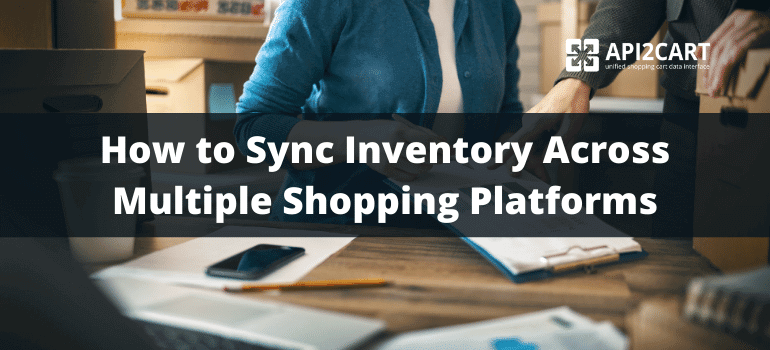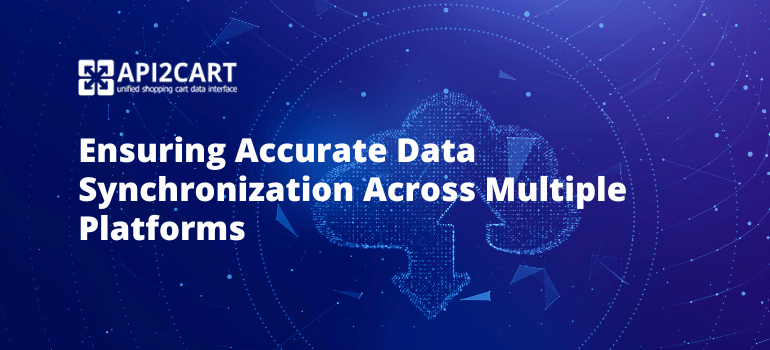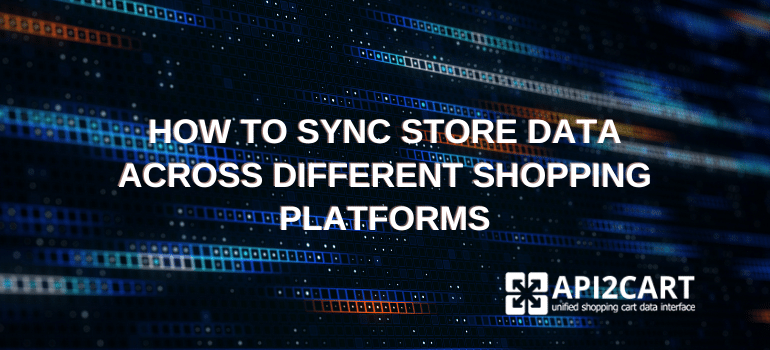
Managing an eCommerce business is challenging when business owners don't have the right tools to run their operations stress-free. One of the essential eCommerce operations is syncing inventory across multiple sales channels. It allows online businesses to perform their function well, and e-retailers can have complete control over their inventory when selling on numerous channels.
With software such as multi-channel, inventory, and ERP systems, e-retailers can automatically synchronize their inventory and monitor it at any point in time. While multi-channel systems manage an eCommerce store across multiple sales channels, inventory management solutions take care of an online store's stock. The ERP system shows all the resources required to manage an eCommerce store.
Such software can track and sync inventory across multiple shopping platforms when integrated with the shopping platforms like Amazon, eBay, WooCommerce, BigCommerce and others.
Inventory Synchronization Process
Inventory synchronization is the process of capturing real-time inventory status across all the sales channels as the transactions happen on each of them. It shows accurate inventory/stock on all the sales channels as the items are sold out, displaying only the available quantity of products to the customers and e-retailers on all the channels.
To sync inventory, the eCommerce software requires data from eCommerce shopping platforms related to the orders and products so they can keep track of product sales. The synchronization process starts with tracking sales on the shopping platforms. After a sale is made, the software updates the product quantity/inventory across all the sales channels and displays the available amount.
The following software allows the e-retailers to track and sync inventory levels automatically for all their sales channels:
- Multi-channel systems
- Inventory management systems
- ERP systems
Multi-channel software needs to update inventory across all the sales channels so they can accurately display product availability. In addition, these systems provide store owners with inventory synchronization capability so they can monitor stock on all the channels and prevent underselling/overselling.
Inventory management software is itself a significant part of the inventory synchronization process as it keeps track of all the products being sold out across all the online stores. Therefore, the e-retailers using this software will know the availability of products on all their sales channels.
ERP systems primarily function to manage all the resources invested in a business. Therefore, these systems play a crucial role in tracking and synchronizing inventory across sales channels. In addition, they manage inventory count accurately on all the channels.

What Data is Required for Inventory Synchronization?
To sync inventory on all the sales channels, the eCommerce systems need access data related to orders and products from all the shopping platforms on which their clients have their e-stores. With the order and product data, the software can track the sales of a particular store on an eCommerce platform and also update the available quantity of products on different sales channels.
eCommerce software must be able to retrieve and manage order and product data from all of their customers' online stores to keep track of sold-out products. Such information can prevent e-retailers from underselling the product if the stock is available but not visible, and/or overselling the product when it is out of stock but inventory indicates otherwise.
eCommerce software are unable to sync inventory across the shopping platforms if it does not have access to order and product data. Such data can be retrieved only with the help of eCommerce integration developed between shopping platforms and eCommerce software. Without integration, no data is available and hence you cannot suggest your eCommerce software to the e-retailers.
Since e-retailers are aware of the general features required in the eCommerce software related to inventory synchronization, the lack of key features will not make your software stand out from the competition. Therefore, developing API integration between eCommerce software and shopping platforms like Shopify, Magento, eBay, PrestaShop, WooCommerce, etc. is an important part of the inventory sync process.
How to Get and Manage Order and Product Data From Shopping Platforms?
To sync inventory across multiple shopping platforms, you need integration between shopping platforms and your eCommerce software which is possible with the help of API2Cart.
API2Cart is a unified API (application programming interface) that can connect your eCommerce software to more than 60 eCommerce platforms and marketplaces, including Magento, WooCommerce, Shopify, BigCommerce, PrestaShop, and others - all at once. You can start working with API2Cart by registering your free account.
API2Cart allows you to automatically integrate your eCommerce software with all the shopping platforms you have selected for integration. In addition, API2Cart has a great number of API methods that enable managing various types of data from multiple platforms.
Hence, if you need data related to orders and products to sync inventory across shopping platforms, API2Cart API methods will allow you to quickly retrieve such data and manage (edit, update, delete) according to the requirements of e-retailers.
API2Cart performs all the integrations at once so that you don’t need to integrate your software with all the shopping platforms one by one. The latter approach leads to a lot of investment and a waste of time, money, and resources.
API2Cart API methods that allow you to retrieve and manage product and order data from shopping platforms’ online stores include:
- webhook for order.add event - With this method set up, the software receives a notification every time a new order is placed in the store. The webhooks enable you to get up-to-date information about the orders, save API requests, and decrease server load
- order.list - You can also track new orders with the order.list method, which returns a list of orders placed on the stores
- product.update - With this method, you can update the stock levels after an order is placed on an e-store.
Here is the response structure of order.list method:
{
"return_code": 0,
"return_message": "string",
"pagination": {
"previous": "string",
"next": "string",
"additional_fields": {},
"custom_fields": {}
},
"result": {
"orders_count": 0,
"order": [
{
"id": "string",
"order_id": "string",
"basket_id": "string",
"channel_id": "string",
"customer": {
"id": "string",
"email": "string",
"first_name": "string",
"last_name": "string",
"phone": "string",
"additional_fields": {},
"custom_fields": {}
},
"create_at": {
"value": "string",
"format": "string",
"additional_fields": {},
"custom_fields": {}
},
"currency": {
"id": "string",
"name": "string",
"iso3": "string",
"symbol_left": "string",
"symbol_right": "string",
"rate": 0,
"avail": true,
"default": true,
"additional_fields": {},
"custom_fields": {}
},
"shipping_address": {
"id": "string",
"type": "string",
"first_name": "string",
"last_name": "string",
"postcode": "string",
"address1": "string",
"address2": "string",
"phone": "string",
"phone_mobile": "string",
"city": "string",
"country": {
"code2": "string",
"code3": "string",
"name": "string",
"additional_fields": {},
"custom_fields": {}
},
"state": {
"code": "string",
"name": "string",
"additional_fields": {},
"custom_fields": {}
},
"company": "string",
"fax": "string",
"website": "string",
"gender": "string",
"region": "string",
"default": true,
"tax_id": "string",
"identification_number": "string",
"alias": "string",
"additional_fields": {},
"custom_fields": {}
},
"billing_address": {
"id": "string",
"type": "string",
"first_name": "string",
"last_name": "string",
"postcode": "string",
"address1": "string",
"address2": "string",
"phone": "string",
"phone_mobile": "string",
"city": "string",
"country": {
"code2": "string",
"code3": "string",
"name": "string",
"additional_fields": {},
"custom_fields": {}
},
"state": {
"code": "string",
"name": "string",
"additional_fields": {},
"custom_fields": {}
},
"company": "string",
"fax": "string",
"website": "string",
"gender": "string",
"region": "string",
"default": true,
"tax_id": "string",
"identification_number": "string",
"alias": "string",
"additional_fields": {},
"custom_fields": {}
},
"payment_method": {
"name": "string",
"additional_fields": {},
"custom_fields": {}
},
"shipping_method": {
"name": "string",
"additional_fields": {},
"custom_fields": {}
},
"shipping_methods": [
{
"name": "string",
"additional_fields": {},
"custom_fields": {}
}
],
"status": {
"id": "string",
"name": "string",
"history": [
{
"id": "string",
"name": "string",
"modified_time": {
"value": "string",
"format": "string",
"additional_fields": {},
"custom_fields": {}
},
"notify": true,
"comment": "string",
"additional_fields": {},
"custom_fields": {}
}
],
"refund_info": {
"shipping": 0,
"fee": 0,
"tax": 0,
"total_refunded": 0,
"time": {
"value": "string",
"format": "string",
"additional_fields": {},
"custom_fields": {}
},
"comment": "string",
"refunded_items": [
{
"product_id": "string",
"variant_id": "string",
"order_product_id": "string",
"qty": 0,
"refund": 0,
"additional_fields": {},
"custom_fields": {}
}
],
"additional_fields": {},
"custom_fields": {}
},
"additional_fields": {},
"custom_fields": {}
},
"totals": {
"total": 0,
"subtotal": 0,
"shipping": 0,
"tax": 0,
"discount": 0,
"additional_fields": {},
"custom_fields": {}
},
"total": {
"subtotal_ex_tax": 0,
"wrapping_ex_tax": 0,
"shipping_ex_tax": 0,
"total_discount": 0,
"total_tax": 0,
"total": 0,
"total_paid": 0,
"additional_fields": {},
"custom_fields": {}
},
"discounts": [
{
"code": "string",
"value": 0,
"type": "string",
"additional_fields": {},
"custom_fields": {}
}
],
"order_products": [
{
"product_id": "string",
"order_product_id": "string",
"model": "string",
"name": "string",
"price": 0,
"price_inc_tax": 0,
"quantity": 0,
"discount_amount": 0,
"total_price": 0,
"tax_percent": 0,
"tax_value": 0,
"tax_value_after_discount": 0,
"options": [
{
"option_id": "string",
"name": "string",
"value": "string",
"price": 0,
"weight": 0,
"type": "string",
"product_option_value_id": "string",
"additional_fields": {},
"custom_fields": {}
}
],
"variant_id": "string",
"weight_unit": "string",
"weight": 0,
"barcode": "string",
"parent_order_product_id": "string",
"additional_fields": {},
"custom_fields": {}
}
],
"bundles": [
{
"product_id": "string",
"order_product_id": "string",
"model": "string",
"name": "string",
"price": 0,
"price_inc_tax": 0,
"quantity": 0,
"discount_amount": 0,
"total_price": 0,
"tax_percent": 0,
"tax_value": 0,
"tax_value_after_discount": 0,
"options": [
{
"option_id": "string",
"name": "string",
"value": "string",
"price": 0,
"weight": 0,
"type": "string",
"product_option_value_id": "string",
"additional_fields": {},
"custom_fields": {}
}
],
"variant_id": "string",
"weight_unit": "string",
"weight": 0,
"barcode": "string",
"parent_order_product_id": "string",
"additional_fields": {},
"custom_fields": {}
}
],
"modified_at": {
"value": "string",
"format": "string",
"additional_fields": {},
"custom_fields": {}
},
"finished_time": {
"value": "string",
"format": "string",
"additional_fields": {},
"custom_fields": {}
},
"comment": "string",
"store_id": "string",
"warehouses_ids": [
"string"
],
"refunds": [
{
"id": "string",
"shipping": 0,
"fee": 0,
"tax": 0,
"total": 0,
"modified_time": {
"value": "string",
"format": "string",
"additional_fields": {},
"custom_fields": {}
},
"comment": "string",
"items": [
{
"product_id": "string",
"variant_id": "string",
"order_product_id": "string",
"qty": 0,
"refund": 0,
"additional_fields": {},
"custom_fields": {}
}
],
"additional_fields": {},
"custom_fields": {}
}
],
"gift_message": "string",
"order_details_url": "string",
"additional_fields": {},
"custom_fields": {}
}
],
"additional_fields": {},
"custom_fields": {}
},
"additional_fields": {},
"custom_fields": {}
}
Conclusion
The eCommerce software vendors need to sync inventory across multiple shopping platforms to help their clients manage their stock effectively. Underselling and overselling can harm a business’s reputation, and as a software vendor, you need to equip your clients with the right software to manage their operations.
Integration between shopping platforms and eCommerce software makes the latter capable of providing necessary features to the e-retailers through their software. Try API2Cart, accessing data from over 60 eCommerce platforms through a single API, and get your 14-day free trial right now!
FAQs
By using API2Cart, you can sync inventory levels in real-time, ensuring that other valuable store data, orders, products, customers, shipments, categories, and more, is always accurate and up-to-date across all connected platforms. This helps prevent overselling and keeps your inventory management streamlined.



